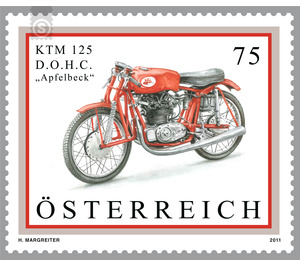motorcycles - Austria / II. Republic of Austria 2011 - 75 Euro Cent
Theme: Science
| Country | Austria / II. Republic of Austria |
| Issue Date | 2011 |
| Face Value | 75.00 |
| Edition Issued | 250,000 |
| Printing Type | offset |
| Stamp Type | Commemorative |
| Item Type | Stamp |
| Chronological Issue Number | 2250 |
| Chronological Chapter | OOS-OE2 |
| SID | 490987 |
| In 56 Wishlists | |
On the history of this motorcycle: Already two years after the presentation of the R 100, the first KTM motorcycle, the Mattighofen entered 1955 in the prestigious road racing. At that time, four-stroke engines offered a more promising basis for the design of a racing machine than the robust two-stroke engine used in reliability racing (today: "Enduro Sport"), as found in KTM's production machines. However, because there was no four-stroke in the KTM program, had two Production Racer MV Agusta serve as an organ donor. The Italian 125 cc engines were built into their own chassis with front fork, the so-called Earles fork, to gain initial experience. In 1956, company boss Hans Trunkenpolz was able to win the successful Austrian engine designer Ing. Ludwig Apfelbeck (1903 to 1987) for his racing machine project. Apfelbeck's short-stroke DOHC engine delivered just under 17 hp at 12,000 rpm and was switched by a six-speed gearbox. The fully disguised machine with a top speed of 180 kilometers per hour was mainly used at national races in Austria, but also at several international races in Germany, where they achieved some notable successes against the dominating brands in the World Cup. Because of the looming motorcycle crisis, the further development of the Apfelbeck KTM was set back at the end of 1957. The previous factory drivers then continued to use the existing machines on a private basis until 1961 on. Outstanding driver was a certain Erwin Lechner from Hallein, who won several state championships in the 125 cc class.


